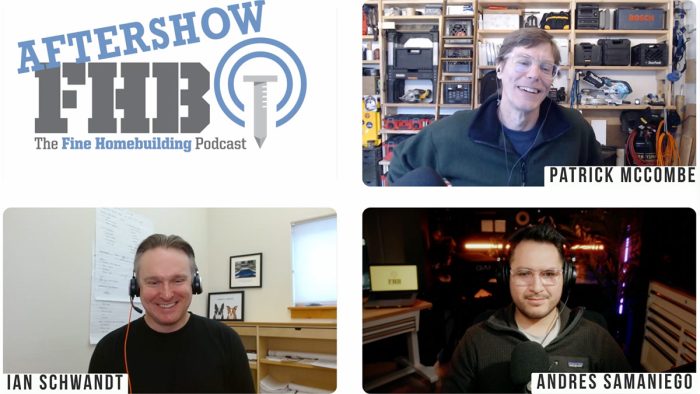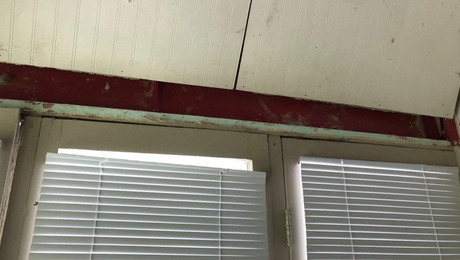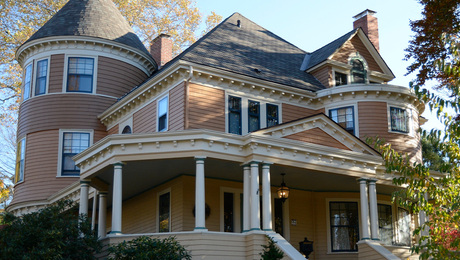Podcast 619: Old-House Construction, Sizing Lumber Beams, and Window Restoration
Listeners write in about handyman businesses, NASA’s stuck screws, and leak detectors and ask questions about old houses, sizing beams, and restoring windows.
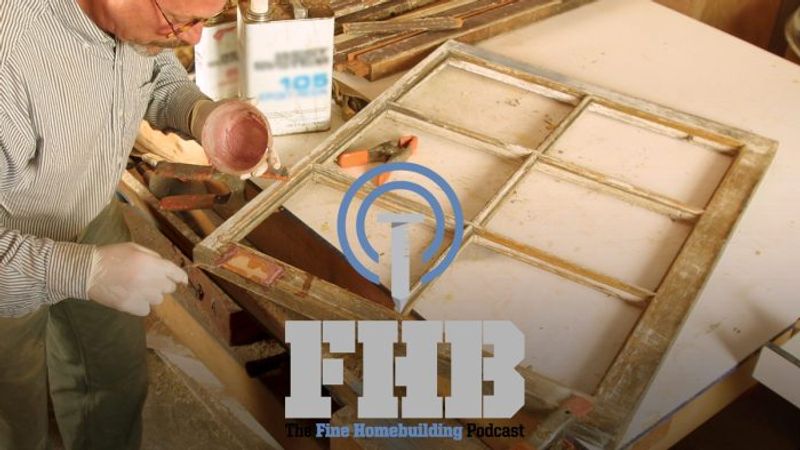
Follow the Fine Homebuilding Podcast on your favorite app. Subscribe now and don’t miss an episode:
 |
Andre describes his handyman business. Michael shares NASA’s fastener frustration. Bob answers the call for feedback on whole-house leak detectors. Ian offers info on EV pickups and vans. Lou is looking for resources that describe how houses are built by era. Chris asks how to size a large deck beam. Campbell alerts the Podcast to proposed New York legislation that would require restoring existing wood windows.
Editor Updates:
- Ian: House and truck update
- Brian: Indoor-air quality upcoming eLearning class
- Andres: Bathroom project
- Patrick: Outdoor lighting
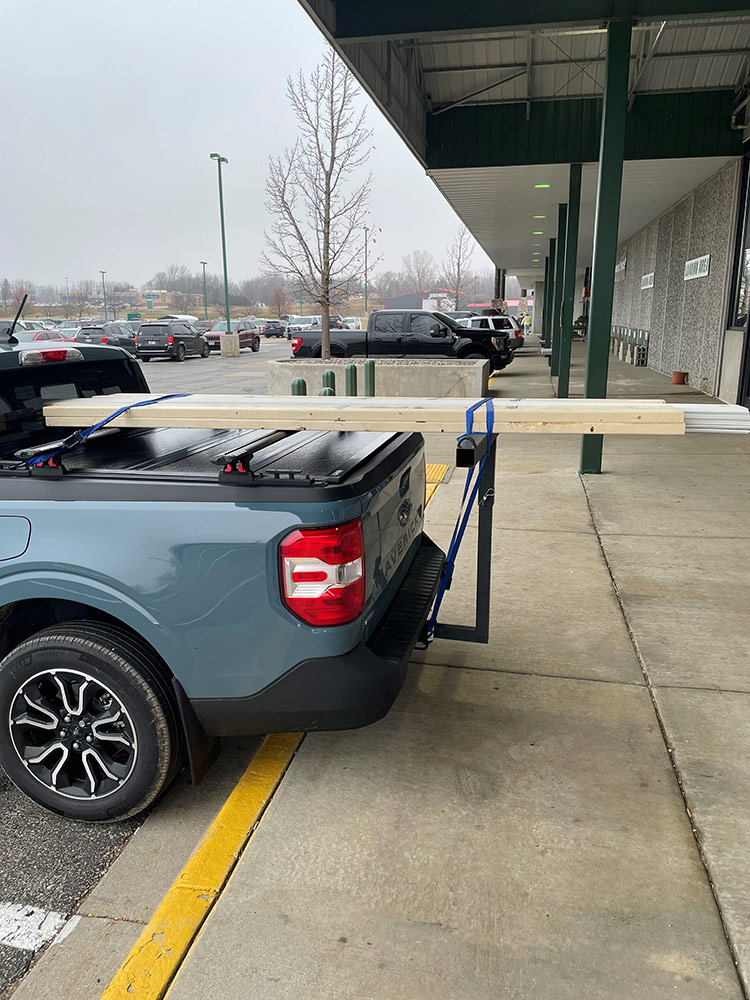 |
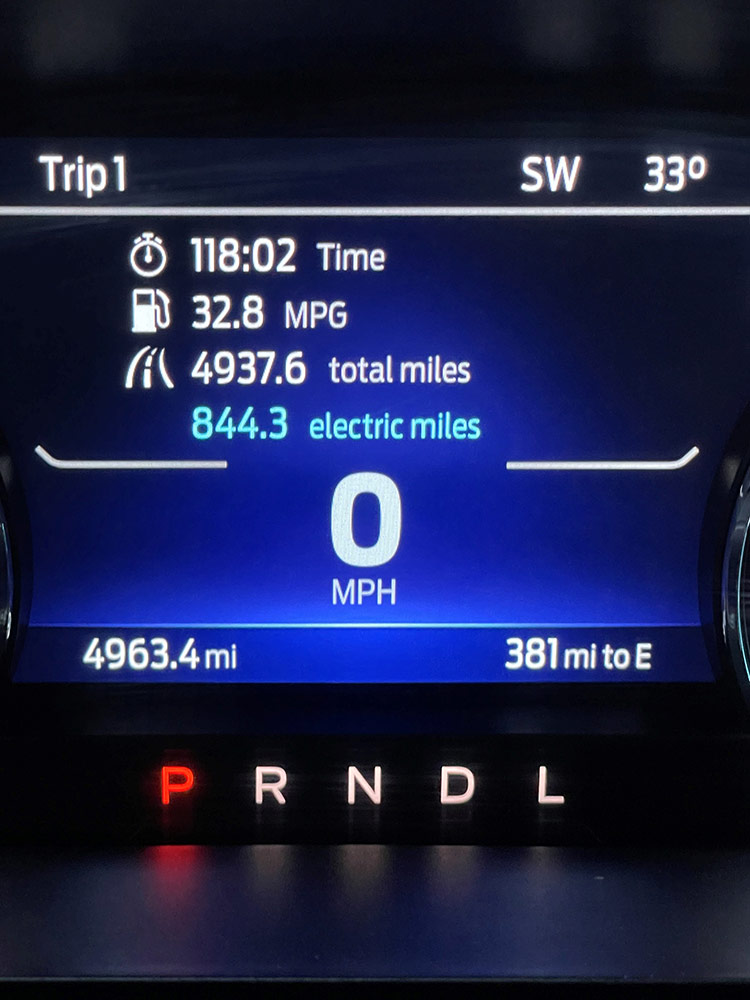 |
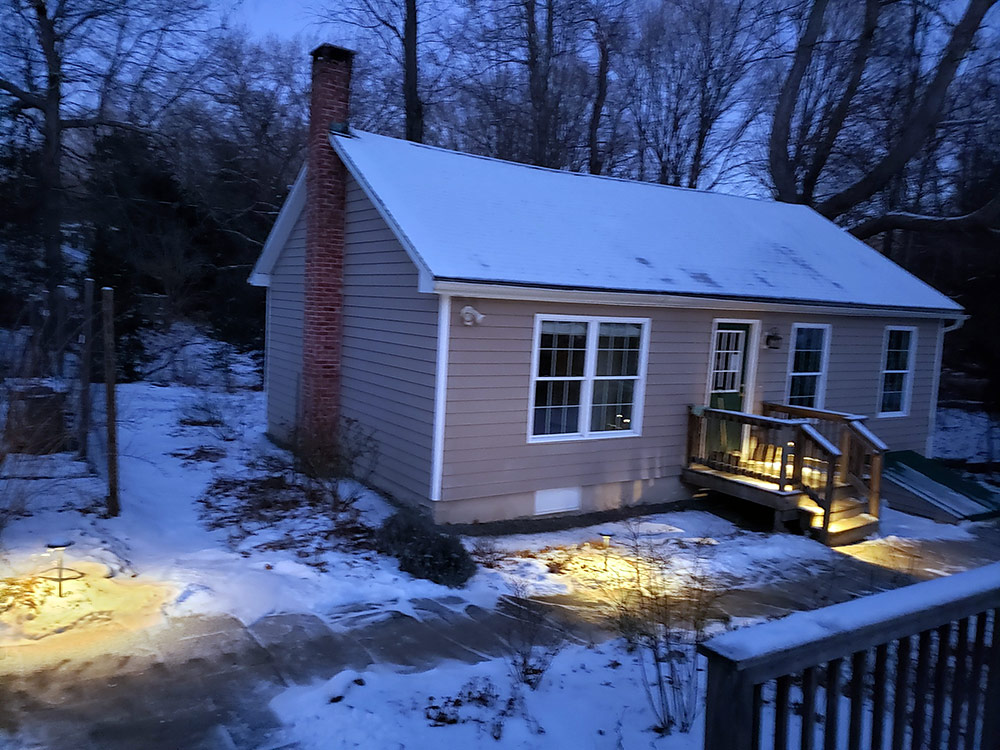 |
Listener Feedback 1:
Andre writes: Good evening gents!
I found your FHB Podcast 614 Aftershow discussion relevant and engaging. I wanted to share my two cents with you as a handyman business owner for the last 2.5 years. To be fair, I’ve been working by myself for about 2 years and only in the last six months started growing the team.
I have a background in software/tech, so it’s been relatively easy for me to promote myself online and bring in business. On the other hand, because I’m pretty new to construction, I had to learn everything on my own, so I have struggled with being able to take on more complex jobs.
As far as I can tell, there is definitely a business opportunity for handyman services. We’re based in San Diego, Calif., and everywhere I go, people ask for my business cards. The potential customer base is much larger than just homeowners, by the way. We’ve worked for property managers, realtors, commercial maintenance, and contractors, too, with great success.
What you mentioned about the retainer/subscription-based handyman model during the podcast really got the gears turning. A year or so ago, I hired someone to do cold-calls to all kinds of real estate professionals in San Diego. We received a great response. A property manager wanted us to do many, many large-unit turns for them, but we had to turn them down because we didn’t have a GC license. Additionally, other property managers wanted a bunch of small work done here and there, but our price and minimum charge were too high for them. This is another reason why I believe there’s a business here and also that the monthly service model might work.
The last thing I should touch on is that arguably the most challenging thing so far has been finding qualified handymen to hire. There’s a lot that goes into being a great handyman. The person obviously needs a broad skill set in the trades. Moreover, they need to be great with clients (usually handymen get sent to jobs by themselves, so they’re always client-facing) and also technologically competent (if you want to scale a business, each handyman needs to know how to clock-in/clock-out for jobs on their phone, upload before/after pictures, search for job materials on their phone, and communicate with their dispatcher). I’ve interviewed countless handymen and, so far, have only found three to four that check all of the boxes.
I’m stoked to continue my handyman business journey. It’s my first-time hiring people, and I’m seeing just how important my role is to the people around me.
Thank you for putting together a great episode. I will certainly be tuning in for more!
Best regards,
Andre
Owner, Andre Handyman
Related Links:
- Podcast 250: PRO TALK With Mike Evans
- Real-World Advice for Pricing Construction Projects
- Why Does a Small Job Cost so Much?
Listener Feedback 2:
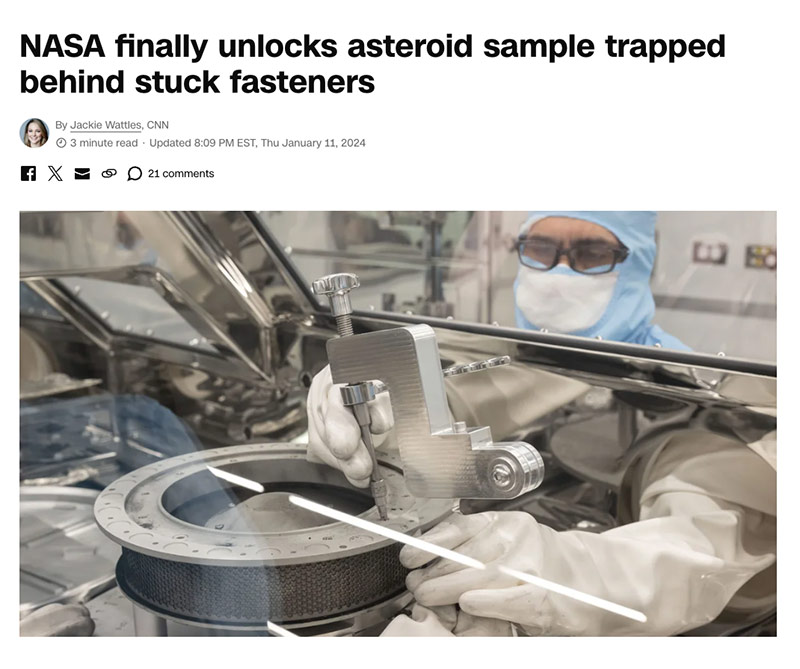
Michael writes about NASA’s stuck screws:
We’ve all been there, haven’t we?
Related Links:
- NASA finally unlocks asteroid sample trapped behind stuck fasteners
- NASA finally opens OSIRIS-REx asteroid sample canister after freeing stuck lid
Listener Feedback 3:
Bob writes: Hi Patrick,
During the podcast you and the team raised two issues I wanted to comment on.
First is the new generation of water-leak detectors. One of the first things I installed after purchasing our house was the Flo by Moen, which provides whole-house leak protection. It works great. If there is a drip (or any unusual water activity), my smartphone gets a notification and, if I don’t override it, the water shuts off. Also, each month I get an email letting me know about my water usage from the prior month.
I’m located in Bethel, Conn., only a couple of miles from your office. You are welcome to stop by and take a look if you’re interested.
The second comment is about moving heavy items. I am enamored with the idea of an Airsled. I don’t have one, but I am looking forward to the time I have a project that will call for the purchase of one.
Love the podcast (and the Aftershow) and agree with everyone that I wish Jeff the best in the future.
Related Links:
Listener Feedback 4:
Ian writes: Hey guys, I’m a first-time listener.
I was intrigued by the EV discussion. Perhaps I’m somewhat qualified to comment because I work both with my wife’s interior architecture & design studio and as a product designer on EV fleet management software at Standard Fleet.
You’re spot on about the pickups (F150 Lightning and Rivian R1T), though there’s a lot more stuff coming—other big OEM pickups, Rivian’s R2 series, the Telo kei-inspired minitruck (which has the capacity of a Tacoma in the footprint of a Mini Cooper).
On the delivery-van side, there are a lot of models available. Where I am located now in Europe, almost every big OEM has an electric version of their delivery van available. The main question is how good the range is. Sometimes the range is small as the vans are mostly meant for a lot of stop-and-go city deliveries, which means low mileage/speed and range isn’t as much of an issue.
Here is a list of the models I found in the U.S., available and coming “soon”:
- Ford E-Transit
- Mercedes eSprinter
- Ram ProMaster EV
- Rivian’s (Amazon) delivery vans are now available for anyone to buy; Rivian uses them as mobile service vehicles, too.
- Lots of other startups like Canoo, BrightDrop (GM), Arrival…at various stages of development.
Hope that helps!
Ian
Question 1: How can I find resources about building practices during different time periods?
Lou in Richmond, Va., writes: Hi Patrick and crew,
I’ve got two questions for the podcast (feel free to tackle them separately or together as you see fit). I’m a big fan and so grateful for the work you do!
1) I started as a carpenter a few years ago with a small general contractor and recently took a new job at a custom-building company as an estimator. I’ve been listening to the podcast every day on my morning commute, and every time I learn something new I’m immediately able to apply it. My job is to interpret what I’m looking at, diagnose problems, and recommend and estimate a plan of action. I often need to make assumptions about what the details of a house may be without the benefit of exploratory demolition.
It seems to me that pro builders are familiar with the changes in building practices over the years and have a mental picture of common assemblies and issues based on the age of the house. Can you direct me to any resources that provide a decade-by-decade overview of common building practices, standard assemblies, and progressive code changes over the years? (This may be a longer discussion best saved for the Aftershow.) Thanks for any help or direction in the subject.
2) I’m writing in to ask for your help in tracking down leads on building courses and workshops in 2024. Can you offer recommendations for training, workshops, and conferences, either in-person or online? I saw that Fine Homebuilding last convened a Summit in 2020. I know planning big events can be a bear and there are some changes happening at FHB, but I would be so excited if you all decide to make it happen again.
Related Links:
- Books Every Builder Should Own
- Review of Structural Materials and Methods for Home Building in the United States: 1900-2000
- 70 Years of the American Home: From Fallout Shelters To Smart Technology
Question 2: How do I size a large beam for my deck?
Chris writes:
I’m trying to size a beam for my deck and determine how far apart the footings need to be. I looked at the deck beam span tables in the IRC, but the biggest beam they have listed is a triple 2×12. I’d like to use a PT 6×12 Hem-Fir beam in the hope of getting a very long, clear span. Are there any code tables or other resources for sizing large beams?
Related Links:
Question 3: New legislation promotes restoration of historic wood windows.
Campbell in New York writes: Hello all,

Cheers,
Campbell
Related Links:
- Restore a Wood Window Sash
- Refurbishing Old Double-Hung Windows
- Use a Steam Box for Window Restoration
Podcast 619: Members-only Aftershow — Ian’s Tips for Construction Budgets
Ian and Patrick talk about the difference between estimates and budgets, how a design/build project works, and avoiding budget busters and forgotten items.
This episode of The Fine Homebuilding Podcast is brought to you by Humboldt

As natural wood species go, redwood is in a class of its own. A sustainable alternative to tropical hardwoods, redwood is grown and harvested to the highest environmental standards in the world. Named for the dark red heartwood at the center of the tree, redwood imparts natural beauty, warmth, and durability to interior and exterior building applications including decking, fencing, paneling, siding, exposed beams and timbers, pergolas, and other shade structures.
To learn more about redwood from Humboldt Sawmill, please visit GetRedwood.com.
Check out one of our latest Project Guides: Energy Retrofit!
Check out our FHB Houses:
Visit the Taunton Store • Magazine Index • Online Archive • Our First Issues • All Access

If you have any questions you would like us to dig into for a future show, shoot an email our way: [email protected].
If we use your question we’ll send you a FHB Podcast sticker!
FHB Podcast T-shirts!
Represent your favorite podcast! Available in several styles and colors. Made from 100% cotton. Find the Podcast t-shirt and more cool products in the Fine Homebuilding Store.
| Fine Homebuilding podcast listeners can now get 20% off anything in the Taunton store, including Pretty Good House.
Use the discount code FHBPODCAST to take advantage of this special offer. |
 |
“Finally, knowledgeable people talking about building reasonably-sized, high-performance houses for normal people with real budgets!” — DanD, VA, 8/19/22, Amazon.com review |
We hope you will take advantage of a great offer for our podcast listeners: A special 20% off the discounted rate to subscribe to the Fine Homebuilding print magazine. That link goes to finehomebuilding.com/podoffer.
The show is driven by our listeners, so please subscribe and rate us on iTunes or Google Play, and if you have any questions you would like us to dig into for a future show, shoot an email our way: [email protected]. Also, be sure to follow Fine Homebuilding on Instagram, and “like” us on Facebook. Note that you can watch the show above, or on YouTube at the Fine Homebuilding YouTube Channel.
The Fine Homebuilding Podcast embodies Fine Homebuilding magazine’s commitment to the preservation of craftsmanship and the advancement of home performance in residential construction. The show is an informal but vigorous conversation about the techniques and principles that allow listeners to master their design and building challenges.
Other related links
-
- All FHB podcast show notes: FineHomebuilding.com/podcast.
- #KeepCraftAlive T-shirts and hats support scholarships for building trades students. So order some gear at KeepCraftAlive.org.
- The direct link to the online store is here.
